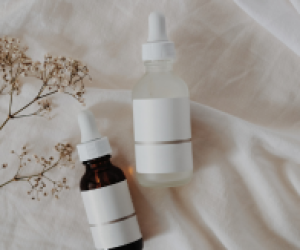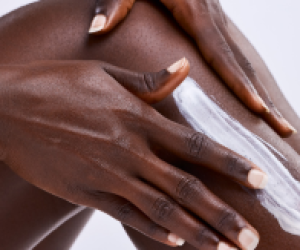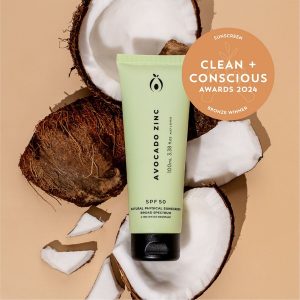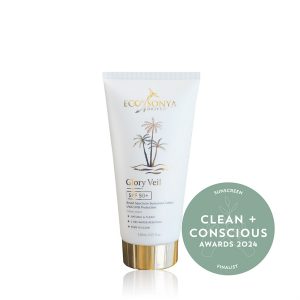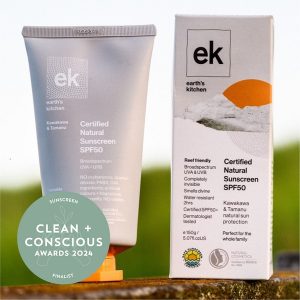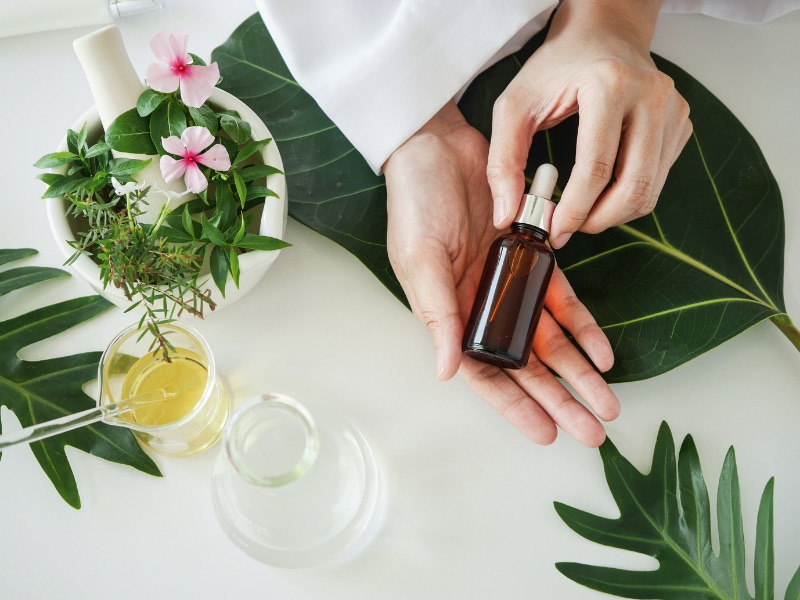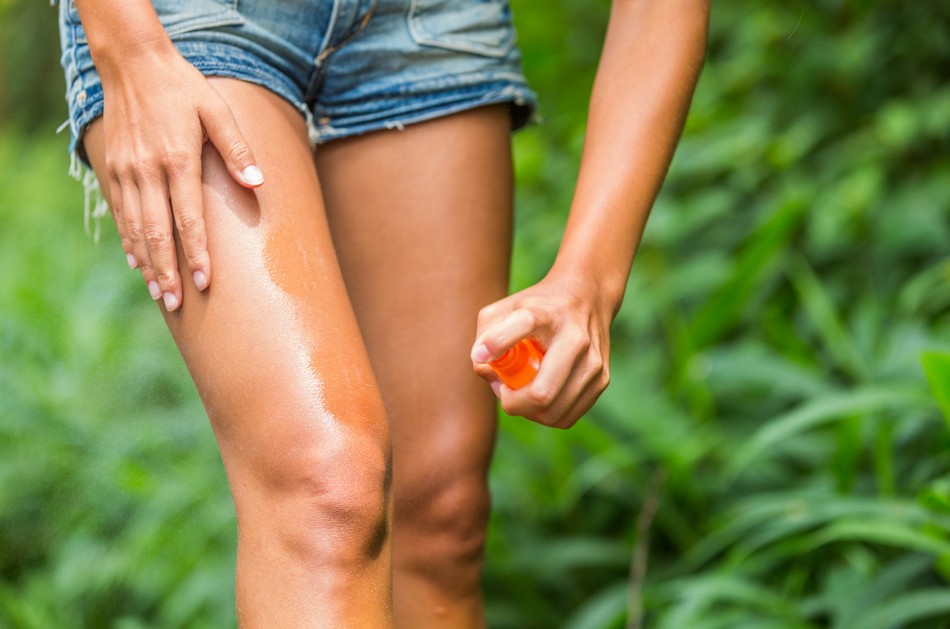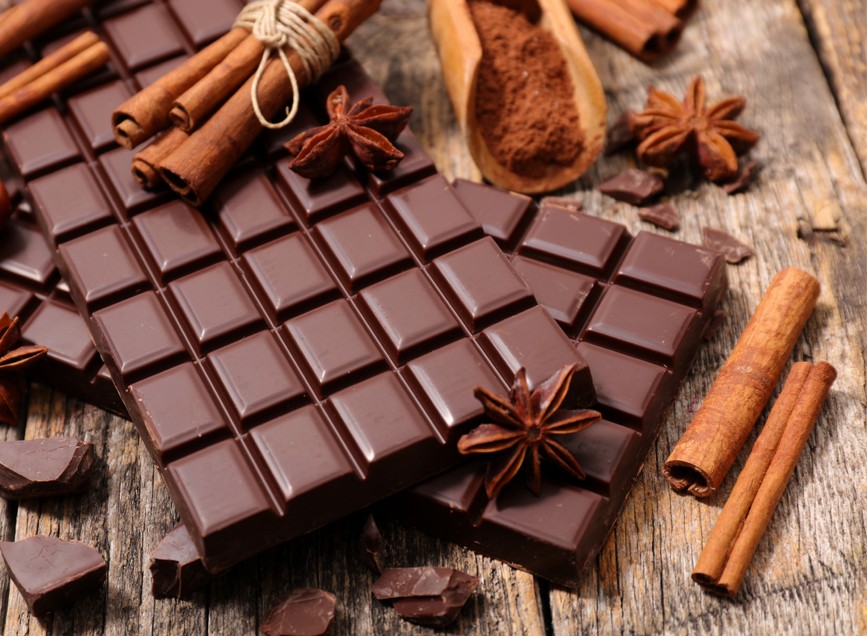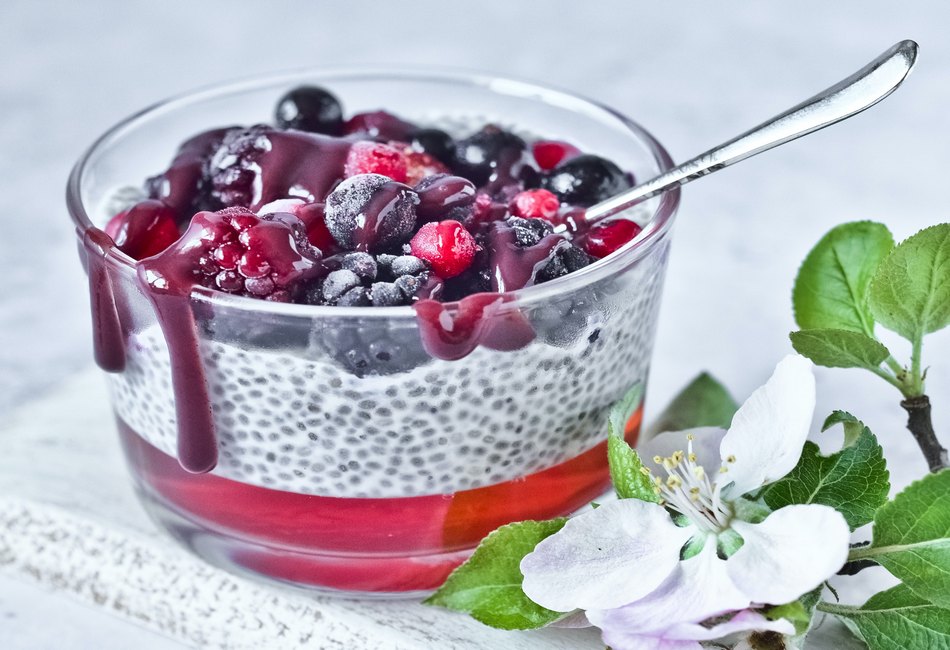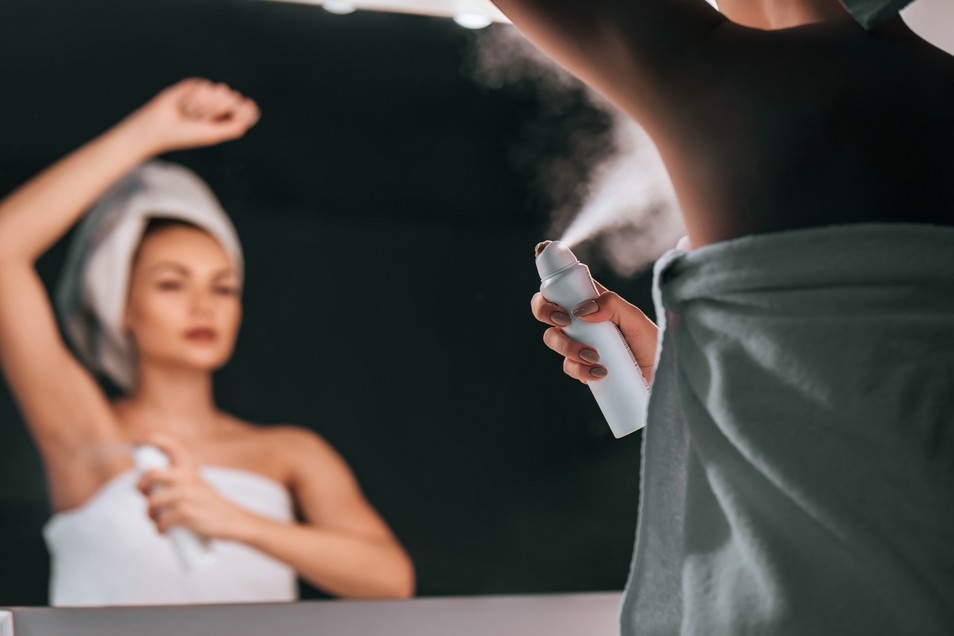Living in Australia, the importance of having a great natural sunscreen on hand is high. Especially if you have children or sensitive skin, you can never have enough sun protection. I personally like to keep a natural sunscreen in each bag so we’re never without it.
When I first started researching sunscreens, I was blown away by what a complex topic it was. I had previously thought that we were almost invincible with a coating of 50+ on us! I’d had no idea that just because a sunscreen has a high SPF rating, it doesn’t mean it blocks harmful UV A radiation – the one that causes deep skin damage and cancer.
We also see sneaky endocrine disruptors appearing in chemical sunscreen formulations too, as well as some other ingredients, that are better avoided.
Luckily there are lots of fantastic products out there which offer broad spectrum protection and are effective, safe, great for sensitive skin and don’t cost a fortune. Join me below on a guide to choosing safe natural sunscreens where I’ll discuss how sunscreens work, what ingredients to avoid and which brands I recommend. (Or just skip to the end to see our best-rated natural sunscreens and read product reviews by our Expert Panel!)

How do sunscreens work?
Sunscreens protect the skin against UV radiation by using either:
Physical blockers which physically block UV by reflecting and scattering it. These are the safest type of sunscreen. Zinc oxide and titanium dioxide are the active ingredients in these sunscreens and they both provide broad spectrum protection – blocking both UV A and B radiation. Zinc oxide is the pick as it is more effective at blocking UV A radiation than titanium dioxide and is also more stable in sunlight. The downside of these sunscreens is that because they form a physical block against the UV and offer broad spectrum protection, they leave a white cast on the skin.
Chemical absorbers may remove the white cast and absorb UV radiation, but these can have endocrine disruptors in them (which we definitely don’t want.) The choice is really up to the consumer—do you choose to have a white cast (which some natural and organic sunscreen cream brands have done a wonderful job of reducing through blending with natural ingredients), or do you risk placing toxic chemicals on your skin?
Nanoparticles
To reduce the white ghosting on the skin, some companies have decided to make the zinc oxide or titanium dioxide particles extremely small – in the nano range. There has been some concern over these changes because when you make particles smaller, they become more easily absorbable and their actions on cells increase too, due to an increased surface area. Thankfully studies so far haven’t been able to show that nanoparticles can absorb beneath the lower layers of our skin and into our bodies, although studies are still ongoing and the jury is still out on it.
As we have a choice of whether to use nano or non-nano particles in our sunscreens, I like to stay on the safe side and choose non-nano zinc oxide sunscreens made with natural ingredients that offer broad spectrum protection. The recommended list will only include natural sunscreens that are non-nano.
What is the SPF rating?
SPF refers to how well a sunscreen acts as a physical shield against UVB radiation – the one which causes the skin to burn. An SPF rating on a physical sunscreen does not have any reference to UVA radiation which penetrates deeper into the skin accelerating skin aging, suppressing the immune system and causing skin cancer. High SPF products can give a false sense of security – when we’re not burning our skin visibly, we think we must be ok and we stay out in the sun longer and reapply sunscreen less often. This was all news to me… I had absolutely no idea! It’s really important to look for a natural sunscreen which offers broad spectrum protection and blocks both UV A and B radiation and apply regularly.
Sun exposure and babies
Babies’ skins have not yet developed melanin, the pigment in the skin that protects from UV. It is therefore advised that infants under 6 months be kept out of direct sun. Instead of using sunscreen for babies, avoid direct sun, stay in shade, use hats and clothing. Over the pram, when my children were babies and toddlers, I used a CoziGo. Each panel around it can be opened or closed which is really useful to block off sun coming in at certain angles. Once your baby is over 6 months old, it is safe to start applying a natural sunscreen before entering direct sunlight.

Vitamin D
Vitamin D is important for strengthening bones and even protecting against some cancer. Vitamin D is produced in our bodies in response to being exposed to sunlight. Some sun exposure is good and sun protection does block Vitamin D being produced – but 10- 15 minutes in the sun unprotected and not between 10am and 2pm, when the sun is at its hottest, is enough!
Ingredients that must be avoided
The following ingredients are all Endocrine/ Hormone disruptors which penetrate the skin and get into the bloodstream. These man-made industrial chemicals interfere with our hormones or their receptors and can have a negative impact on our health.
- Oxybenzone (benzophenone-3)
- Octyl-dimethyl-PABA
- Octinoxate (Octyl methoxycinnamate/ OMC)
- 4-Methylbenzylidene camphor
- Padimate O (2-ethylhexyl-4-(dimethylamino) benzoate
- Fragrance/ Parfum: This can be made up of hundreds of undeclared chemicals. Often including parabens and phthalates which are endocrine disruptors. It can however be made from natural organic essential oils which are totally safe, though sometimes may carry a bit of an increased risk of skin irritation. If it’s not marked as fragrance coming from a natural essential oil, then don’t use it.
Other ingredients to avoid
- Retinyl palmate: this is a form of vitamin A. On sun-exposed skin, a recent study has shown that it may speed the development of skin tumours and lesions and form free radicals that damage DNA.
- Methylisothiazolinone (MI): This has been the cause of some horrific allergic reactions and is a leading cause of dermatitis. It’s banned in the EU from being used in baby wipes.

Avoiding Insect Repellent Combinations
It is not advised to combine insect repellents with sunscreens. Studies have shown that combining sunscreens and repellents leads to increased absorption of the repellent ingredients. Insects are also often less of a problem during peak sun exposure hours and sunscreen needs to be more frequently applied than insect repellent.
Avoiding Spray Sunscreens
Whilst spray sunscreens may seem like the perfect solution, it’s best to use a cream instead. This is because sprays pose an inhalation risk, especially for children. Sunscreen particles were definitely not designed to be breathed into little lungs! You also tend to apply spray sunscreens in a thinner layer and it’s much easier to miss a spot.
Protect Oceans with Reef Safe Sunscreens
When choosing a sunscreen, it’s essential to consider its impact on marine life, particularly coral reefs. A study has found that oxybenzone, a common ingredient in many sunscreens, is especially harmful to corals. When exposed to high doses, oxybenzone caused coral bleaching, DNA damage, abnormal growth, and developmental deformities in baby corals. To protect these vital ecosystems, opt for reef-safe sunscreens that are free from oxybenzone and other harmful chemicals. Look for mineral sunscreens containing zinc oxide or titanium dioxide, which provide effective sun protection without posing a threat to coral reefs. By making this simple switch, you can enjoy the sun while safeguarding our oceans.
Safe natural sunscreens
There are no 100% protective natural sunscreens. The best defence against the sun is to wear a hat, sunglasses and cover the body with clothing. It’s also advised to avoid spending extended periods of time in the sun during the hottest time of the day between 10am – 2 pm.
- The following natural sunscreens are:
- Broad spectrum – giving both good UVA and UVB protection
- Non – nanoparticle Zinc Oxide as the active ingredient
- Have no toxic ingredients
- Come from socially responsible brands who make it their mission to create ethical and sustainable products
-
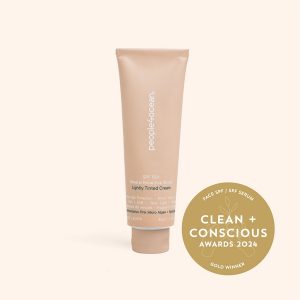 People4Ocean – SPF50+ Mineral Bioactive Shield | Lightly Tinted Cream
People4Ocean – SPF50+ Mineral Bioactive Shield | Lightly Tinted Cream -
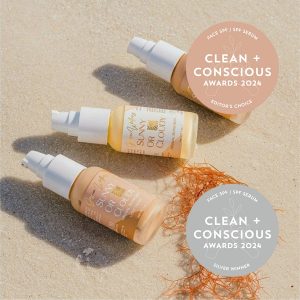 Jessica Wellness Australia – Sunny or Cloudy 30 SPF Mineral Sunscreen
Jessica Wellness Australia – Sunny or Cloudy 30 SPF Mineral Sunscreen -
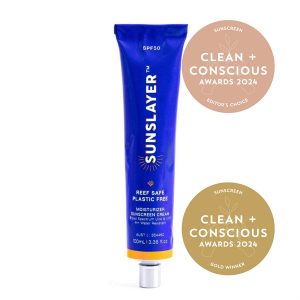 SUNSLAYER – Natural Face & Body moisturiser Sunscreen Cream SPF50+
SUNSLAYER – Natural Face & Body moisturiser Sunscreen Cream SPF50+ -
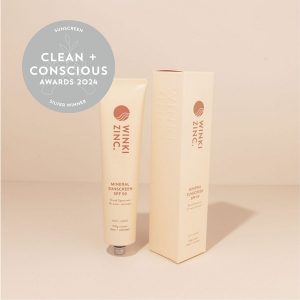 Winki Zinc – Mineral Sunscreen SPF 50
Winki Zinc – Mineral Sunscreen SPF 50 -
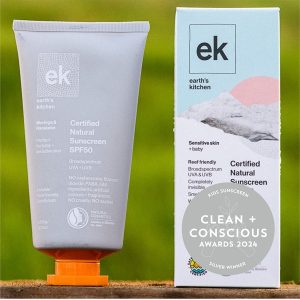 EK Sunscreens – Moringa & Harakeke Sensitive / Baby SPF50 Sun Protection
EK Sunscreens – Moringa & Harakeke Sensitive / Baby SPF50 Sun Protection
Recommended Natural Sunscreens
These are our Clean + Conscious Awards 2024 winning products. For full product and hands-on reviews, click on the links below.
- Gold Winner: SUNSLAYER – Natural Face & Body Moisturizer Sunscreen Cream SPF50+
- Silver Winner: Winki Zinc – Mineral Sunscreen SPF 50
- Bronze Winner: EK Sunscreens – Kawakawa & Tamanu SPF50 Natural Sun Protection
- Finalist: Avocado Zinc – SPF 50 Natural Physical Sunscreen
- Finalist: Eco By Sonya Driver – Glory Veil SPF 50+
Recommended Kids Natural Sunscreens
These are our Clean + Conscious Awards 2024 winning products. For full product and hands-on reviews, click on the links below.
- Gold Winner: SUNSLAYER – Natural Face & Body Moisturizer Sunscreen Cream SPF50+
- Silver Winner: EK Sunscreens – Moringa & Harakeke Sensitive / Baby SPF50 Sun Protection
- Bronze Winner: People4Ocean – P4O 50+ ZINC STICKS
- Finalist: ARLOE wellness – Under the Sun – Bambini
- Finalist: The Nude Alchemist – SPF30 Sunscreen

Recommended Face Natural Sunscreens
These are our Clean + Conscious Awards 2024 winning products. For full product and hands-on reviews, click on the links below.
- Gold Winner: People4Ocean – SPF50+ Mineral Bioactive Shield | Lightly Tinted Cream
- Silver Winner: Jessica Wellness Australia – Sunny or Cloudy 30 SPF Mineral Sunscreen
- Bronze Winner: SUNSLAYER – Natural Face & Body Moisturizer Sunscreen Cream SPF50+
- Finalist: INIKA Organic – Natural Sunscreen SPF50+ 50mL
- Finalist: Sabbia Co – Daily Sun Shield SPF50+ Mineral Sunscreen

And remember! We’re all on a learning journey! Never feel guilty if you were using a product that wasn’t ideal, just get excited with your new knowledge and make better choices when you know better! (It’s something I have to do all the time!)
